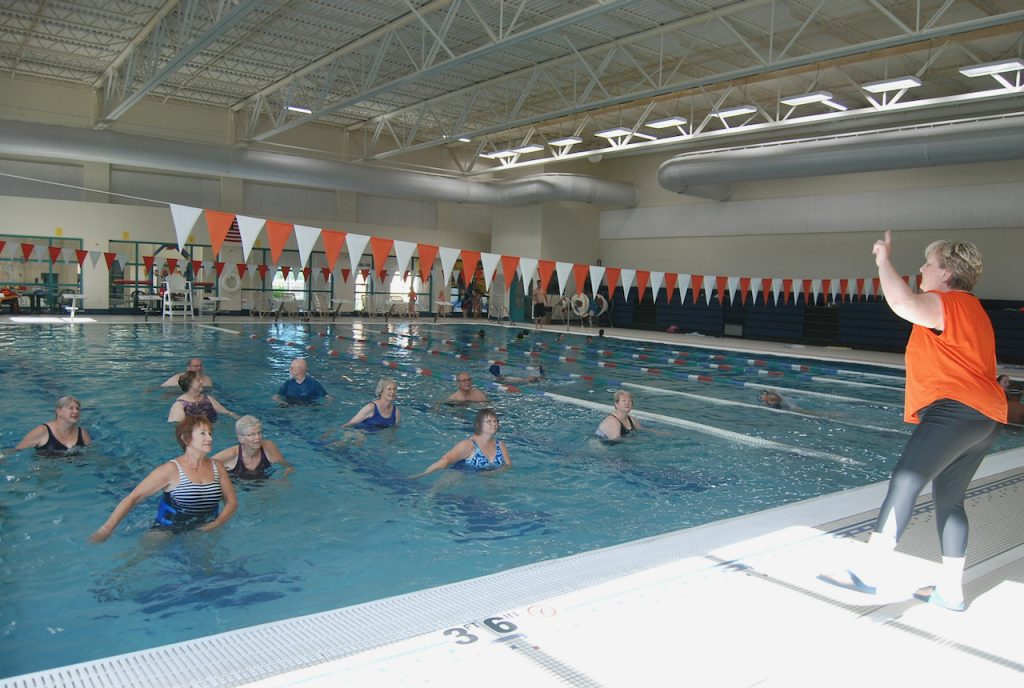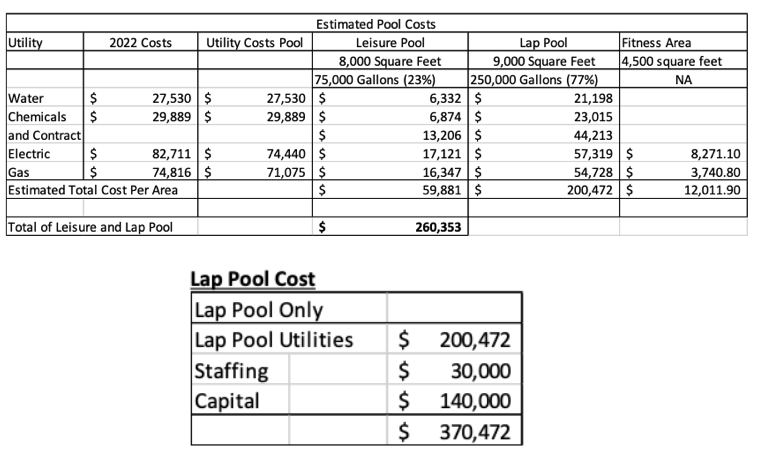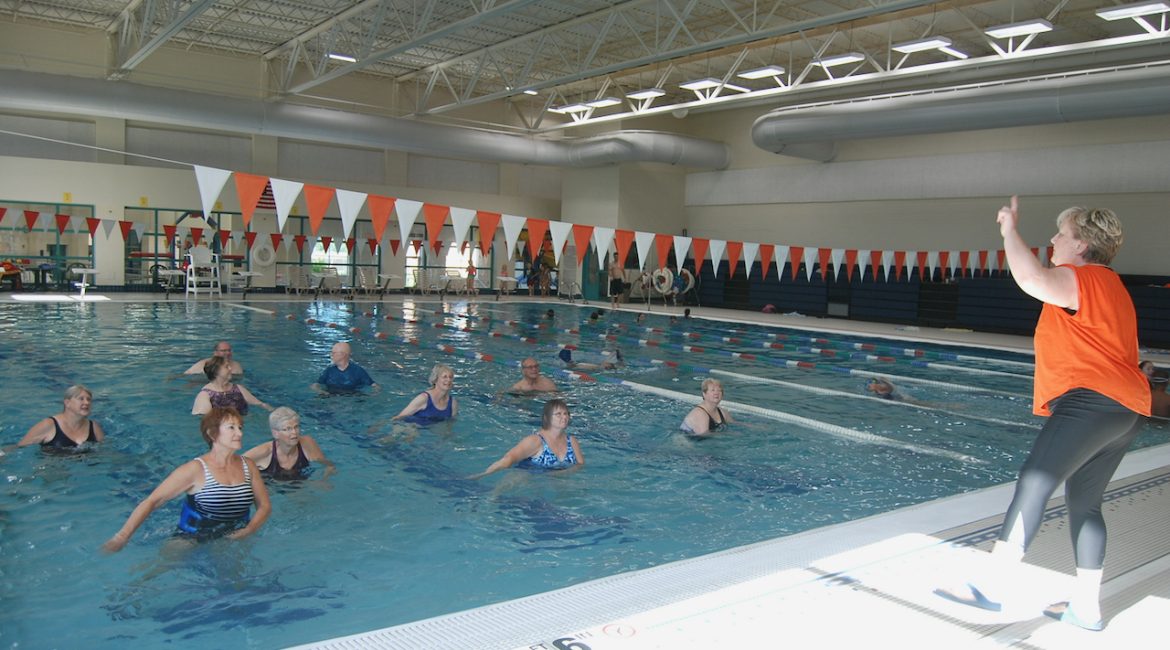By Kim McDarison
Revenues associated with concessions sold at the Whitewater Aquatic and Fitness Center have decreased between the 2021-22 and 2022-23 school year by 51%, according to information released Tuesday by Whitewater city officials.
Revenues associated with concessions sales at the aquatic center, and costs associated with keeping the facility open, have been developed in advance of the next Whitewater Aquatic and Fitness Center Subcommittee meeting, and shared with members of the Whitewater Common Council and the Whitewater Unified School District, according to a memo from Whitewater City Manager John Weidl.
The next subcommittee meeting will be held Wednesday, June 14, at 6 p.m., in the Whitewater High School library, 534 S. Elizabeth St., Whitewater.
Members of the subcommittee, composed of members of the Whitewater Unified School District Board of Education and the Whitewater Common Council, expressed interest in learning details about aquatic center concessions sales during their last meeting, held May 11.
The two parties have been engaged in an ongoing negotiating process to determine obligations that each party will assume associated with continued operations and a leasing agreement of the aquatic and fitness center since March.
The aquatic center has been operating without a lease agreement between the two parties — the district, which owns the facility, and the city, which leases and operates it — since 2021. A former agreement, through which the two parties split the operating and capital improvement costs associated with the facility, had been in place, prior to 2021, since 2016.
A drop in concessions sales
During the May meeting, Whitewater Common Council and subcommittee member Jill Gerber said a decision made by the district disallowing high school students to visit the center at lunchtime “cut about $30,000 out of our operating costs.”
In response to the claim, Whitewater Unified School District Superintendent Caroline Pate-Hefty questioned whether $30,000 attributed to concessions sold at the aquatic center was an accurate number.
Gerber noted that it was a number she had “heard,” but could not say it was “exact.”
Within his memo shared Tuesday, Weidl offered an eight-month, September through April, look at concessions revenues at the center for each of seven years, between 2017 and 2023.
Looking more broadly, comparing concessions revenues made during the 2018-19 school year with those made during the 2022-23 school year, Weidl said concessions revenues decreased by 79%.
In actual numbers, according to the memo, in 2018-19, which is notated as a “pre-COVID” year, the aquatic center made $44,338 in concessions sales. This year, 2022-23, which is notated as a year during which the district placed restrictions disallowing students to visit the center during lunchtime, concessions sales total $9,224.
Looking at the full seven-year period, a chart within the memo notes that, in 2017, concessions sales totaled $51,385; in 2018, they totaled $54,069; in 2019, they totaled $56,441; in 2020, notated as a year that was affected by COVID, they totaled $13,214; in 2021, sales came in at $10,669; in 2022, notated as the year in which the district’s schools reopened after closing as a COVID-19 precaution, sales totaled $20,771, and in 2023, with sales calculated between January and April, the total is $4,846.
Estimated pool costs
Also discussed during the May 11 meeting was the cost associated with programming at the aquatic center run by the city and school district.
Operating and lease agreement proposals submitted in May by each negotiating entity, the city and district, offered figures which, according to each party, represents what each party should pay towards operating and capital improvement costs associated with the aquatic facility.
In May, the city proposed continuing an earlier agreement, which split the costs of facility-related expenses between the two parties, for a period of 15 years, with each entity contributing $219,000 annually. The proposal stipulated that $70,000 also would be contributed by each party for the proposed costs of capital expenditures and maintenance.
Within the district’s proposal, a fee of $7,500 was proposed to be paid by the district annually to the city to cover operating expenses associated with the district’s use of the pool, outlined as athletic and summer school programming. In addition, the district proposed that it would become responsible for all of the facility’s capital and maintenance costs, and it would make available for that purpose $250,000 by placing those dollars in its Fund 80 account, used for community programming-related expenditures. The district proposed entering into a contract with the city for a period of 1-3 years.
Before and during the May meeting, city officials have said that the annual cost associated with the district’s pool use is about $63,000.
During the May meeting, Pate-Hefty said that the district had shared with its athletic director information provided by the city showing the number of hours the city estimated that the district was using for pool programming.
Responding to the estimates, she said the athletic director was “not sure we agree with all the hours that are posted here.”
She said she would need to verify the $63,000 figure.
Charts, showing cost estimates for pool operations, were included Tuesday in a memo released by Weidl to the negotiating parties and Fort Atkinson Online.
In his memo, Weidl wrote: “Heating the pool water and powering the mechanical room are the most significant costs to the facility.”
According to a chart, labeled “Estimated Pool Costs,” in 2022, costs were as follows: Water, $27,530; chemicals, $29,889; electric, totaling at $82,711, with $74,440 attributable to pool costs, and gas, totaling at $74,816, with $71,075 attributable to pool costs.
Looking at a breakdown by center amenity, the chart noted that the 8,000-square-foot leisure pool holds 75,000 gallons of water and the 9,000-square-foot lap pool holds 250,000 gallons of water. The fitness area is 4,500 square feet.
Water and chemical costs, and an annual chemical contract, costing more than $50,000, were shared between the two pools, with 23% of those costs attributed to the leisure pool and 77% attributed to the lap pool.
The fitness center shared in costs associated with electricity and gas, with its total impact on utilities listed at $12,011.
Total utility costs associated with both the leisure and lap pools were estimated at $260,353.
According to the memo, would the district become responsible for operating the lap pool and providing the required staffing, based on its current programming levels, it would face operating costs of approximately $230,000 annually. Looking more closely at costs, the city estimates that the lap pool utilities would come at an annual cost of $200,472, staffing would cost $30,000 and, using the city’s capital improvement plan (CIP), annual investments and maintenance costs would add $140,000, for a total annual operations and maintenance cost of $370,000.
Would the district opt to continue with a partnership with the city, using a shared distribution of costs model, each entity would pay $219,000 in annual operating costs and $70,000 in annual capital and maintenance costs, bringing the total annual operating and capital costs for each entity to $289,000, which, would be less expensive for the district, the memo argued.
The memo noted that the full annual cost to continue providing the Aquatic and Fitness Center as a community and district asset, including each entity’s full annual contribution, would the parties choose to continue their partnership, is $578,000.
The memo concluded by stating: “Based on the provided city staff research, continuing the partnership as proposed by the City of Whitewater Common Council results in a decreased cost of operations for the WUSD as opposed to WUSD running the lap pool for their usage alone, without the benefit of the existing partnership.”
City to consider fitness center only lease option
Within an earlier email to Fort Atkinson Online, Weidl wrote: “Staff is also working internally on a proposal that would only lease the space, at market rate or $15 a square foot, for the fitness center, spin and aerobic classes, and corresponding non-pool related amenities.”
The city manager noted that in that situation, the Whitewater Aquatic and Fitness Center, or WAFC, would be called the Whitewater Fitness Center, or WFC.
Would the city lease just the fitness center, it would continue to offer an “aerobic and anaerobic experience that will retain the 24-hour fitness component, spin and other fitness classes, as well as a revamped focus on wellness and nutrition,” the email stated.
Additionally, Weidl wrote: “In this situation the WUSD will be free to run their swimming class and athletics free from city operations and they can staff and fund that operation on their own. And in this situation, they would have a stream of revenue (from) the city in terms of a market rate lease agreement on the space we’re renting for the WFC.”
An earlier story during which the subcommittee discussed each negotiating entity’s lease and operating agreement proposal for the Whitewater Aquatic and Fitness Center is here: https://fortatkinsononline.com/aquatic-center-subcommittee-debates-merits-of-contractual-proposals-city-to-extend-new-draft/.
An earlier story with documents as shared by each negotiating party outlining their proposals is here: https://fortatkinsononline.com/officials-share-proposals-in-advance-of-upcoming-aquatic-center-subcommittee-meeting/.



This post has already been read 4870 times!
